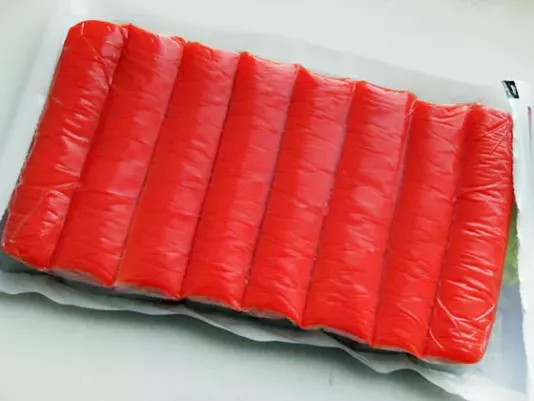Pancake with Crab Sticks and Green Onions
Pancake with crab sticks and green onions - in the season of green onions, when they are elastic, juicy and crispy, prepare such a light and satisfying pancake.

Crab sticks are a product that requires a thoughtful approach if we want more than just a quick result – a dish with character. Over years of cooking, I’ve learned that even simple sticks can taste new if you know a few secrets. They’re made from surimi fish paste, which has a delicate flavor and absorbs seasonings well. That’s why I always recommend combining them with lemon zest, a little garlic, or herbs – it adds brightness. It’s important not to overload them with heavy sauces: too much fat mutes their natural freshness. I always keep an eye on temperature during heating – excessive heat makes them dry and tough. In my kitchen, they’re a lifesaver when I need to prepare something delicious quickly without sacrificing quality.
When choosing crab sticks, I first pay attention to the ingredients. A quality product should be based on surimi – minced white fish – not starch or soy protein. Over years of cooking, I’ve learned that color also matters: overly bright red sticks often contain too much dye, which can give dishes an artificial aftertaste when heated. I always choose those with an even pink-coral hue and a firm yet springy texture. If a stick breaks easily when pressed or leaves moisture behind, it means it contains too much water or has been thawed multiple times – best to avoid such products. Storage also plays a key role: even the best sticks lose flavor if kept open near strong-smelling vegetables. I always pack leftovers in an airtight container to prevent odor absorption. For salads, I prefer chilled sticks, and for hot dishes – frozen ones, as they hold their shape better during heating. Ultimately, choosing the right product is the first step toward a delicious dish where texture, aroma, and tenderness come together in harmony.
Before adding crab sticks to dishes, I always make sure they’re properly prepared. If frozen, I thaw them gradually – first in the refrigerator, then for a few minutes at room temperature. Sudden immersion in hot water ruins their structure, turning firm pieces into mush. Over time, I’ve noticed that gently patting them dry with a paper towel before cutting improves the flavor and makes cooking easier. For salads, I often shred them into thin strands – this helps them absorb the dressing better while standing out among other ingredients. If I plan to fry them, I cut larger pieces to retain juiciness. One more trick: before heating, I sometimes marinate them briefly in a mix of lemon juice, a drop of oil, and a pinch of sugar – it enhances the natural sweetness of the fish protein. In my experience, preparation isn’t a minor step but an essential part of the process that shapes the flavor. When we give it proper attention, the result always exceeds expectations.
Temperature control is the key to success. Crab sticks don’t require long cooking, and it’s important not to overheat them. On medium heat, they release their aroma while remaining tender. I often sauté them in butter until lightly golden, which takes just 2-3 minutes. When baking, the oven temperature should not exceed 180°C (356°F), otherwise the protein coagulates too quickly, creating a dry texture. Over years of practice, I’ve learned to sense the exact moment they’re done: their color becomes evenly pale, and the aroma resembles a sea breeze with creamy notes. For soups, I add them at the end of cooking to preserve their tenderness. On high heat, they harden quickly, so I work fast but carefully. Cooking techniques vary – from steaming to grilling – but the main rule remains the same: minimal heat, maximum flavor. This preserves natural moisture and keeps the dish light and aromatic.
In my kitchen, crab sticks often serve as a base for flavor experiments. Their mild taste pairs well with spicy, tangy, and creamy notes. I always look for balance: lemon adds freshness, mayonnaise brings softness, and a touch of mustard or wasabi adds intensity. Through years of cooking, I’ve noticed they work best with light sauces based on yogurt or sour cream with herbs like dill, parsley, or green onion. When making salads, I always monitor the salt level – crab sticks already contain some salt, and excess can ruin the harmony. For hot dishes, I use creamy sauces with a hint of lemon or a light tomato base. Another proven trick is pairing them with rice and a touch of soy sauce – it deepens the flavor without oversalting. The key is not to overuse spices: the gentle aroma of seafood calls for delicacy. The right sauce is like a frame for a painting – it highlights the essence without overshadowing it.
Over years of cooking, I’ve seen even experienced chefs make the same mistakes. The most common one is overheating. Crab sticks are delicate, and prolonged frying or baking causes the protein to separate, making the texture fibrous and the taste bland. I always monitor the time – even a few extra minutes can ruin everything. Another mistake is improper storage. If kept near strong-smelling foods, crab sticks absorb odors that are hard to mask even with sauces. That’s why I store them separately in sealed containers. Yet another issue is using low-quality mayonnaise or too many spices, which overpower the gentle surimi flavor. In my practice, quality control starts with attention: checking expiration dates, texture, and even the smell after opening the package. If there’s the slightest doubt, it’s better not to risk it – easier to replace the product than to spoil the dish. Following these principles guarantees a consistent, clean taste that both clients and loved ones have praised me for many times.